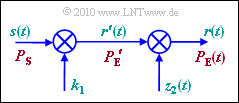Exercise 1.2Z: Lognormal Fading Revisited
We assume similar conditions as in the Task 1. 2 but now we summarize the purely distance-dependent path loss $V_0$ and the mean value $m_{\rm S}$ of the lognormal–fading (the index „S” stands for Shadowing): $$V_{\rm 1} = V_{\rm 0} + m_{\rm S} \hspace{0.05cm}.$$
The total path loss is then given by the equation $$V_{\rm P} = V_{\rm 1} + V_{\rm 2}(t)$$
where $V_2(t)$ describes a lognormal–distribution with mean value zero: $$f_{V{\rm 2}}(V_{\rm 2}) = \frac {1}{ \sqrt{2 \pi }\cdot \sigma_{\rm S}} \cdot {\rm exp } \left [ - \frac{ V_{\rm 2} ^2}{2 \cdot \sigma_{\rm S}^2} \right ] \hspace{0.05cm}.$ The path loss model shown in the graphic is suitable for the scenario described here: *Multiply the transmitted signal $s(t)$ first with a constant factor $k_1$ and further with a stochastic quantity $z_2(t)$ with the probability density (WDF) $f_{\rm z2}(z_2)$, then the signal $r(t)$ results at the output, whose power $P_{\rm E}(t)$ is of course also time-dependent due to the stochastic component. *The WDF of the lognormally distributed random variable $z_2$ is for $z_2 ≥ 0$: $$f_{z{\rm 2}}(z_{\rm 2}) = \frac {{\rm exp } \left [ - {\rm ln}^2 (z_{\rm 2}) /({2 \cdot C^2 \cdot \sigma_{\rm S}^2}) \right ]}{ \sqrt{2 \pi }\cdot C \cdot \sigma_{\rm S} \cdot z_2} \hspace{0.3cm}{\rm with} \hspace{0.3cm} C = \frac{{\rm ln} \hspace{0.1cm}(10)}{20\,\,{\rm dB}}\hspace{0.05cm}.$$ *For $z_2 ≤ 0$ this WDF is equal to zero. ''Notes:'' * The task belongs to the chapter [[Mobile_Communication/Distancedependent%C3%A4ngige_D%C3%A4mpfung_und_Abschattung|Distance-dependent attenuation and shading]]. * Use the following parameters: $$V_{\rm 1} = 60\,{\rm dB}\hspace{0.05cm},\hspace{0.2cm} \sigma_{\rm S} = 6\,{\rm dB}\hspace{0.05cm}.$$ * The probability that a mean-free Gaussian random variable $z$ is greater than its dispersion $\sigma$, is $${\rm Pr}(z > \sigma) = {\rm Pr}(z < -\sigma) = {\rm Q}(1) \approx 0.158\hspace{0.05cm}.$$ * Also applies: ${\rm Pr}(z > 2\sigma) = {\rm Pr}(z < -2\sigma) = {\rm Q}(2) \approx 0.023\hspace{0.05cm}.$ * Again for clarification: $z_2$ is the linear fading–size, while the description size $V_2$ is based on the tenner–logarithm. *The following conversions apply: $$z_2 = 10^{-V_{\rm 2}/20\,{\rm dB}}\hspace{0.05cm}, \hspace{0.2cm} V_{\rm 2} = -20\,{\rm dB} \cdot {\rm lg}\hspace{0.15cm}z_2\hspace{0.05cm}.$ ==='"`UNIQ--h-0--QINU`"'Questionnaire=== '"`UNIQ--quiz-00000002-QINU`"' ==='"`UNIQ--h-1--QINU`"'Sample solution=== '"`UNIQ--html-00000003-QINU`"' '''(1)''' The constant $k_1$ generates the time-independent path loss $V_1 = 60 \ \rm dB$. From this follows: '"`UNIQ-MathJax29-QINU`"' '''(2)''' Correct is only the <u>second solution suggestion</u>: *For the Gaussian random variable $V_2$ all values between $–∞$ and $+∞$ are (theoretically) possible. *The transformation $z_2 = 10^{{\it –V_2}\rm /20}$ results in only positive values for the linear random variable $z_2$, namely between 0 (if $V_2$ is positive and reaches to infinity) and $+∞$ (very large negative values of $V_2$). '''(3)'' The random value $z_2$ can only be positive. Therefore the WDF–value $f_{\rm z2}(z_2 = 0)\hspace{0.15cm} is \underline{ = 0}$. *Der WDF–Wert für den Abszissenwert $z_2 = 1$ erhält man durch Einsetzen in die gegebene Gleichung: :'"`UNIQ-MathJax30-QINU`"' *Der erste Anteil ist gleich dem WDF–Wert $f_{{\it V}2}(V_2 = 0)$. *$C$ berücksichtigt den Betrag der Ableitung der nichtlinearen Kennlinie $z_2 = g(V_2)$ für $V_2 = 0 \ \rm dB$ bzw. $z_2 = 1$. *Schließlich erhält man für $z_2 = 2$: :'"`UNIQ-MathJax31-QINU`"' '''(4)''' Berücksichtigt man den Zusammenhang zwischen $z_2$ und $V_2$, so erhält man: :'"`UNIQ-MathJax32-QINU`"' :'"`UNIQ-MathJax33-QINU`"' :'"`UNIQ-MathJax34-QINU`"' *Die Wahrscheinlichkeit, dass eine Gaußvariable größer ist als $2 \cdot \sigma$, ist aber gleich ${\rm Q}(2)$: :'"`UNIQ-MathJax35-QINU`"' '''(5)''' Richtig ist der <u>Lösungsvorschlag 3</u>: *Die erste Aussage ist mit Sicherheit nicht zutreffend, da sich der Mittelwert $m_{\rm S}$ auf die logarithmierte Empfangsleistung (in $\rm dBm$) bezieht. *Um zu klären, ob nun die zweite oder die dritte Lösungsalternative zutrifft, gehen wir von $P_{\rm S} = 1 \ \rm W$, $V_1 = 60 \ \rm dB$ ⇒ $P_{\rm E}' = 1 \ {\rm µ W}$ und folgender $V_2$–WDF aus: :'"`UNIQ-MathJax36-QINU`"' *In der Hälfte der Zeit ist dann $P_{\rm E} = 1 \ \rm µ W$, während in den beiden anderen Vierteln jeweils gilt: :'"`UNIQ-MathJax37-QINU`"' :'"`UNIQ-MathJax38-QINU`"' *Der Mittelwert ergibt somit: :'"`UNIQ-MathJax39-QINU`"' *Diese einfache Rechnung mit diskreten Wahrscheinlichkeiten anstelle einer kontinuierlichen WDF deutet darauf hin, dass der <u>Lösungsvorschlag 3</u> richtig sein wird. *The WDF–value for the abscissa value $z_2 = 1$ is obtained by inserting it into the given equation: '"`UNIQ-MathJax40-QINU`"' *The first portion is equal to the WDF–value $f_{{{\it V}2}(V_2 = 0)$. *$C$ considers the amount of the derivative of the non-linear characteristic $z_2 = g(V_2)$ for $V_2 = 0 \ \rm dB$ or $z_2 = 1$. *Finally, for $z_2 = 2$: '"`UNIQ-MathJax41-QINU`"' '''(4)''' If you take into account the relationship between $z_2$ and $V_2$, you get '"`UNIQ-MathJax42-QINU`"' '"`UNIQ-MathJax43-QINU`"' '"`UNIQ-MathJax44-QINU`"' *The probability that a Gaussian variable is greater than $2 \cdot \sigma$, but equals ${\rm Q}(2)$: '"`UNIQ-MathJax45-QINU`"' '''(5)''' Correct is the <u>solution 3</u>: *The first statement is certainly not correct, since the mean value $m_{\rm S}$ refers to the logarithmic received power (in $\rm dBm$). *To clarify whether the second or the third solution alternative is correct, we assume $P_{\rm S} = 1 \ \ \rm W$, $V_1 = 60 \ \ \rm dB$ ⇒ $P_{\rm E}' = 1 \ {\rm µ W}$ and the following $V_2$–WDF '"`UNIQ-MathJax46-QINU`"'V_{\rm 2}= +10\,\,{\rm dB}\text{:} \hspace{0.3cm} P_{\rm E}(t) \hspace{-0.1cm} \ = \ \hspace{-0.1cm} \frac{1\,\,{\rm W}}{10^7} = 0.1\,\,{\,}{\rm µ W}\hspace{0.05cm},'"`UNIQ-MathJax47-QINU`"'V_{\rm 2}= -10\,\,{\,}{\rm dB}\text{:} \hspace{0.3cm} P_{\rm E}(t) \hspace{-0.1cm} \ = \ \hspace{-0.1cm} \frac{1\,\,{\rm W}}{10^5} = 10\,\,{\,}{\rm µ W}\hspace{0.05cm}.'"`UNIQ-MathJax48-QINU`"'{\rm E}[P_{\rm E}(t)] = 0.5 \cdot 1\,{\rm µ W}+ 0.25 \cdot 0.1\,{\rm µ W}+ 0.25 \cdot 10\,{\rm µ W}= 3.025\,{\rm µ W} > P_{\rm E}\hspace{0.05cm}' = 1\,{\rm µ W} \hspace{0.05cm}.$$
- This simple calculation with discrete probabilities instead of a continuous WDF indicates that the solution 3 will be correct.
